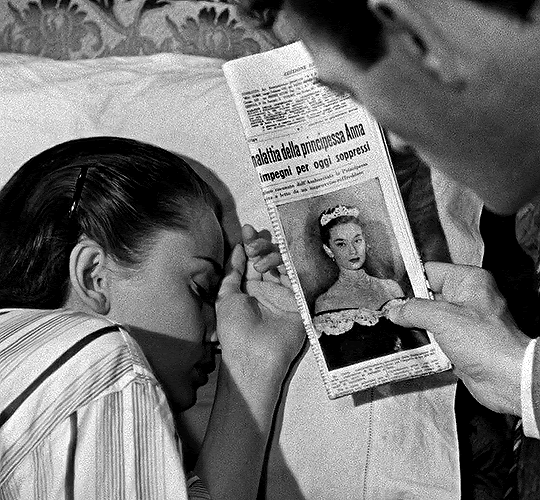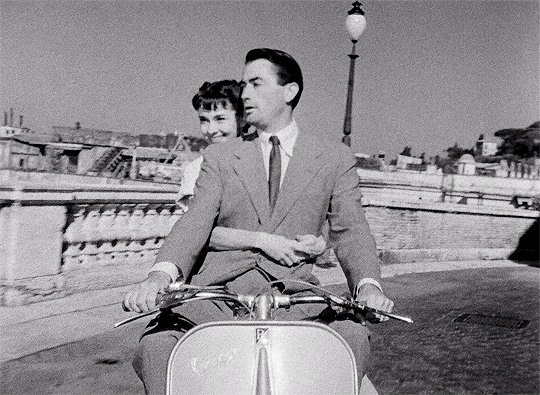Five Questions I Had Watching...Roman Holiday
Let me wax and wax and wax and wax philosophic about Roman Holiday. Or let me re-watch it and find some questions that need answering, whatever works for you!
Here are Five Questions I Had Watching...Roman Holiday!
1. What were hair trends of the 1950s?
Much is made of Audrey's pixie cut and how contre-temps it truly was, so what exactly was the mode at the time Roman Holiday was filmed? According to various fashion and beauty websites, long hair was still the style...until Roman Holiday hit theatres and Audrey Hepburn's pixie was introduced to a wider audience. Then, that became the style.
In the January 1954 issue of Photoplay, Mike Connolly interviews Audrey and this is the lede: "By Hollywood standards—and one must never minimize Hollywood standards!—Audrey Hepburn is flat-chested, slim-hipped and altogether un-Marilyn Monroe-ish. Her measurements are: bust 32”; waist 20.5”; hips 34”. Nothing sensational there, is there? And year, Hollywood standards or no, Audrey Hepburn is the most phenomenal thing that’s happened to the film capital since Marilyn Monroe! Figure that out and you’ve got the answer to what makes Hollywood tick."
Later, describing her: “Her hair was cut very short, even shorter than it was after the actor who played the hairdresser in Roman Holiday had finished chopping it off so recklessly!”
But, to actually answer the question: the hair trends of the '50s included The 'poodle' (think Lucille Ball, with the pouf of bangs), the bouffant, and ponytails.
2. What was the fascination with filming in Rome, Italy in the mid-century?
Filming movies became de reigeur in the post-war era, enough so that Rome became known as Hollywood on the Tiber for the sheer amount of films produced there.
Roman Holiday, like many films of the decade, was made at Cinecittà Studios, the largest film studio in the country at 99 acres. The Studios were built in the '30s by the Fascist government, was bombed during the Second World War, and became a displaced persons camp in the immediate aftermath of the war. Following its rebuilding, it became a famous movie studio that would eventually see over 3,000 films made there, of which 90 were nominated for Oscars and 47 won.
The reason why it was so popular? It was easy to get subsidies to film there, and the production costs were lower. And with the backdrops there, it added an element to films like Ben-Hur and Cleopatra. Federico Fellini was closely associated with Cinecittà Studios; so was Rossellini, Francis Ford Coppola, and other great directors of the time.
Following a decline in the quality of movies made there, in the '70s, Cinecittà Studios seems to have lost its lustre, and it was later sold off. Today it's still the site of film and television productions, but there's also an amusement park on site.
3. Did Gregory Peck really demand that Audrey Hepburn get above-the-title billing on Roman Holiday?
This is going to be a long one, but it depends on who you ask and which source you believe, because according to Gregory Peck and his camp, he saw Audrey's natural talent and insisted that she shared title billing with him because to ignore her was a mistake. If you believe William Wyler and the studio camp, then Audrey was always going to get title billing. The truth is out there, to get all X-Files on you, but let's explore why both camps insist that their version of events is the truth.
But maybe first, let's explore why above the title billing was so important in those days. Title billing is reserved for the major stars of the film. Think Clark Gable. Think Bette Davis. Think Audrey Hepburn (thanks or no thanks to Gregory Peck). If they made a film, their name went above the title of the movie on all its marketing.
The example on the Wikipedia page for this highlights Superman (1978): Christopher Reeve played the titular superhero but wasn't above the title. That honour was shared between Marlon Brando and Gene Hackman, who were the established, money-making stars at the time. It can become a whole 'thing' with stars demanding their names appear in a certain place (honestly, the movie posters for Avengers: Infinity War and Avengers: End Game should be a case study in this) in the credits. I'm just glad it's not my job.
Anyways! According to the oft-repeated story from Gregory Peck's version of events: Audrey's credit on the poster was going to be a small 'Introducing Audrey Hepburn' below the title of the film when filming began. Then when he saw how talented she was, he called up his agent and said that they needed to do the work to get Audrey title billing, because she was the real star of the film.
His contract at the time included a clause that he'd get solo star billing above the title, but he was adamant that he saw the writing on the wall as far as her talent was concerned. He would say: "We all knew that this was going to be an important star and we began to talk off-camera about the chance that she might win an Academy Award in her first film." (She did.)
But according to Hollywood biographer Donald Spoto in Enchantment, his biography of Audrey Hepburn, Gregory Peck merely "delighted" in sharing his version of events, though they didn't match the actual happenings, which was that Wyler and Paramount Pictures decided that Audrey's name needed to be above the title, but knew that it was going to be a fine walk to get their way with Gregory's solo billing clause.
According to Spoto, Wyler and Gregory went out to lunch, discussed the parameters, and it was agreed that Audrey's credit needed to be moved. But Gregory's agent made sure that his client was still treated better, and the Gregory Peck/Audrey Hepburn styling wasn't one he'd agree to. Instead, the title billing eventually read: "A Paramount Picture presenting Gregory Peck and introducing Audrey Hepburn..."
All of this to say that this entire episode wasn't done with malicious intent. Audrey and Gregory truly adored each other, became swift friends on set and remained that way for the rest of her life. In the hours following her death in 1993, he appeared on television to recite a poem in her honour. True friends, indeed.
4. Wasn't Gregory Peck's soon-to-be wife a journalist?
She was! Gregory Peck met his second wife Veronique Passani when she landed the interview of a lifetime. She was a reporter with France Soir and was tasked with chatting with him before he flew to Rome. He would later say about meeting her: "We had lunch on the Left bank in Paris in a bistro. She was 19, and I was 36 years old. She was a journalist, and I was immediately attracted to her… We just talked. There was sort of a wonderful gaze and a deep intelligence and great poise about her..."
Veronique would travel to Rome to interview him on set, and then a few months later, he called her up in the newsroom to ask her out to lunch. She said: "Everyone in the newsroom was stunned when he called.He asked me to lunch, but I had an interview with Albert Schweitzer so I offered to meet him later in the day. At 3:30 Dr. Schweitzer was still having meetings and I had to decide whether to keep my interview or keep my date. I decided to keep my date, and now I kid Gregory and say, ‘If I’d kept my interview with Dr. Schweitzer, I might be a widow in the Congo today!’"
Gregory and Veronique married on New Year's Eve 1955 and remained married until his death in 2004. Veronique passed away from heart failure in 2012.
5. Who were the monarchs of Europe at the time?
- Queen Elizabeth II of the United Kingdom
- King Frederick IX of Denmark
- King Gustaf VI Adolf of Sweden
- King Haakon VII of Norway
- King Baudouin of the Belgians
- Queen Juliana of the Netherlands
- Grand Duchess Charlotte of Luxembourg
- Prince Rainier III of Monaco






Comments
Post a Comment